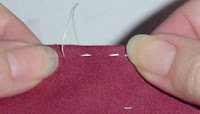Running Stitch / Basting Stitch / Gathering Stitch
 Running Stitch:
Running Stitch:
Use this when you are joining a seam that has no stress. This is great for side seams on skirts & dresses, loose jackets or shirts, etc.
Also great for lightweight fabrics.
Do not use it for seams with stress, or very heavy fabric, as it pulls out easily.
You can use this as a top-stitch on informal garments like aprons, shawls, dressing gowns, etc. but not on formal garments like gowns or dress coats (for these, use a very short top-stitch that covers 3-4 threads and is made one stitch at a time... therefore, not a true running stitch).
 1. Secure your thread.
1. Secure your thread.
2. Load the fabric onto the needle evenly with up & down OR back & forth motions.
I like to use my left index finger & thumbnail to move the fabric onto the needle, rather than moving the needle (this makes for fewer Band-aids).
You can load up to 4 stitches on a long needle, but 2-3 is a good number.
 3. Gently pull the thread through, making sure you have a straight stitching line. If it's not straight, pull the thread out & do it over.
3. Gently pull the thread through, making sure you have a straight stitching line. If it's not straight, pull the thread out & do it over.
Because....
If this is a seam, you will want it to lay flat & even.
If it's top-stitching, you want it to look good.
 Basting Stitch:
Basting Stitch:
This is used to hold 2 or more pieces of fabric together. It can be long & even, long and short (alternating), or even diagonal (not shown here).
This stitch is intended to be removed, so I like to use an alternate or contrasting color thread. Only tie loose knots so it can be easily removed after your actual seam is finished.
 Gathering Stitch:
Gathering Stitch:
Gathering is a way to get a lot of fabric into a little space. You can make ruffles, flounces, etc. using this method.
For light gathers, use a 2:1 ratio. For moderate gathers, a 3:1 ratio, and for tight gathers a 4:1 ratio. This means for every 1" of finished seam you have 2", 3" or 4" of cut material.
There are many different kinds of gathering stitches, but this is the basic template all others are built off of.
Use a heavy hand-sewing thread to gather fabric as it may take a bit of tugging, and you don't want it to break (standard machine sewing thread is not strong enough).
1. Mark center of fabric to be gathered.
2. Using a single thread that is longer than your final seam length, make 2 rows of loose running stitches OR basting stitches parallel to each other; about 1/8" apart on the edge of the fabric to be gathered.
3. Gather each side evenly & sew seam.
4. Remove gathering threads.
Back-Stitching:
 This stitching method is used to make seams that take a lot of stress. Fitted garments like bodices, pants or breeches, waistbands, stays, corsets, etc. This seam does not move and is remarkably durable.
This stitching method is used to make seams that take a lot of stress. Fitted garments like bodices, pants or breeches, waistbands, stays, corsets, etc. This seam does not move and is remarkably durable.
It's great to use on heavier fabrics as it will hold them in place better than straight stitching.
Do not use this stitch if your seam has to 'give' or stretch.
Back-stitching should look the same on the front as the back in thicker material, or have a slight overlap on the back with thinner material.

 1. Secure your thread.
1. Secure your thread.
2. Put the needle in behind where the first thread comes out & bring it out slightly ahead.
3. Put the needle in where the first stitch ends & bring it out in front of the second.
4. Repeat until seam is finished.
Back-stitching is also a way of securing thread if you don't want knots.
Make 2 or 3 overlapping back stitches (all in the same place) and continue your seam.
History of these stitches:
All of the stitches featured here have been used as early as the 11th century, and probably long before that.
The basic running stitches were used for side seams on dresses, 'tunics' and robes. They are most often used in combination with a knotted thread & will hold for a very long time. If a seam is stressed, it is easy enough to pull that section back into shape if the thread isn't broken. If the thread is broken, it's easy enough to repair.
If a person wanted a little more strength in the seam, two running stitches might be used; one going one way, the other in the opposite direction, so thread-fabric-thread becomes thread-thread-thread.
Back-stitches were used on the upper garments of everyone, and the lower garments of men & boys. Again, because these are seams that take the most stress.
Gowns sometimes go from running stitches in the skirt portion to back-stitches in the bodice. This is a very economical use of thread, as the running stitch takes 1/2 the length of the back-stitch.
Many seams were 'left raw', which means the only treatment the cut fabric got was the single seam. Others were 'finished' in some other way. For the most part, it is not necessary to 'finish' seams unless it is a much-washed garment like a shirt or shift. (Or if you are throwing it in the washing machine like a sensible modern person).
No comments:
Post a Comment